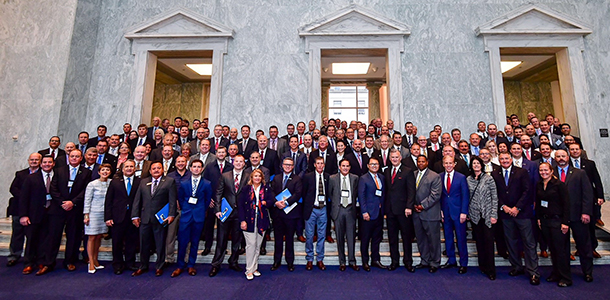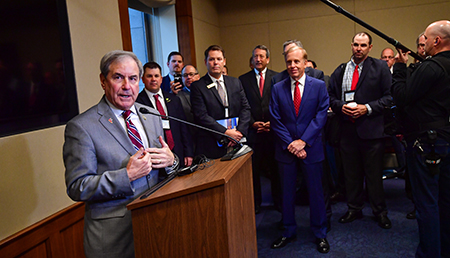by Garrett Johnston
Wednesday, April 25, marked the 11th annual National Golf Day. Many of us celebrated at our office desks, after work, or on golf courses. While others took up Topgolf on their free five-minute lessons.

In Washington, D.C., a conglomerate of golf’s governing bodies and industry leaders known as WE ARE GOLF organized a group of nearly 275 members of the golf community (a record in this event’s history) who met with lawmakers in 290 appointments with the goal of raising the profile of the golf industry to Congress and educating and advocating on specific issues including tax, environment and labor.
The overall event, which included a Swing Analysis station from GOLFTEC, a Simulator from aboutGolf and Titleist, a Congressional Putting Challenge and other activities, took place in the Rayburn Foyer in the Rayburn Building on Capitol Hill.

One of the fun highlights included Representative Bill Keating from Massachusetts spending nearly 30 minutes in the Simulator with renowned instructor Michael Breed.
Keating enjoyed some friendly tips, and views the game as a nice escape from his day job.
“It started with me with the pressure of the job, and I love getting outdoors,” Keating said. “The idea that you could get out there and play a sport for most of your life was attractive to me. And as I’ve gotten older, it’s become an important time with my son, who’s 27, and how many hours can you spend with people when you live in different places (than on a golf course)?”
Keating’s son Patrick used to caddie at the historic venue, The Country Club in Brookline, as well as the Golf Club of Cape Cod.
“He used to give me one stroke on every hole, even par-3s and I’d still lose to him,” Keating laughs.
Keating represents Massachusetts’ 9th district which includes Cape Cod, the South Coast, South Shore, Martha’s Vineyard, and Nantucket – a region rich with golf destinations – and he understands the economic impact the game has there.

“(Golf) not only impacts jobs around the golf course itself and the hospitality features of it,” Keating said. “It has a secondary effect for other businesses because people will come, travel, and golf there. So all the secondary businesses are there too and those are not even counted in the overall economic impact of golf.”
What is counted in the economic impact of golf is that 1.89 million jobs around the U.S. are affected by the business. This accounts for approximately one in 75 U.S. jobs.
At this year’s National Golf Day, WE ARE GOLF revealed in their U.S. Golf Economy Report that the industry numbers from 2016 show golf contributed $84.1 billion to the nation’s economy, a record high. These reports are revealed roughly every five years.
WE ARE GOLF Chairman Jay Karen, who is also the CEO of the National Golf Course Owners Association, says, “There’s a refrain for National Golf Day, and generally we are telling the story of our economic and charitable impact, and we gotta beat that drum every single year. From a public policy ask, we’ll have topics in tax, environment, and labor every single year unless they fix them.
“But we’re talking Washington here, and so if we expect them to fix all of our issues by the 12th National Golf Day (next year), that’s just not going to happen.”

Steve Mona, CEO of the World Golf Foundation and another principal leader of WE ARE GOLF, met with politicians for much of National Golf Day. He sees a lot of positives that came out of the day on Capitol Hill.
“Enthusiasm was as good as it’s ever been,” Mona said. “The reception we’re receiving is great.”
When asked what aspects of the game Mona was most excited to share with politicians, he emphasized diversity and accessibility.
“I’m excited about the changing face of the game, that’s a great story,” he said. “We’ve been traditionally perceived as a game for one group only, and the reality is very different than that and it’s changing very dramatically.”
Mona announced that from 2011 to 2016 there’s been a 20 percent increase in junior golf participation, roughly 500,000 kids, and 33 percent of junior golfers are girls which is a record high; and 33 percent of all junior golfers are from a non-caucasian background which is also a record.
“As juniors matriculate into the game we will have a very different-looking game when they become adults,” Mona said.
“The other thing is the accessibility of golf,” Mona said, “with 75 percent of facilities being open to the public, and they account for 80 percent of all rounds played.”
To see more information on other topics related to this event such as health and wellness, the environment, and charity, go to www.WeAreGolf.org.
Garrett Johnston is a writer and video producer. Follow him on Twitter @JohnstonGarrett.

